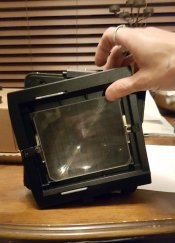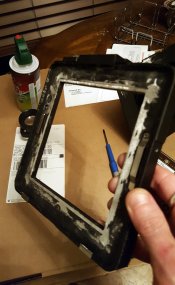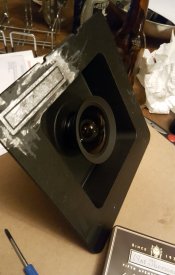Hi Bert and All,
I'm also planning to construct a simple fixed focus camera for 5x7 paper negatives. I can see that ground glass isn't too hard, but I wonder if I can use a piece of vellum or something like that just for one time setting the focus? My idea was to try to set the focus just before I build the back onto the camera ( mine will not take film holders, but will use a clever "storage" compartment that I saw Joe use on F295. I've picked out a lens that might work, but perhaps something simple like this could also be used to check coverage. Anyhow, I'm going to give that a try. Mine will be extremely simple.
P.S. Bert, I was born the same year your Schneider-Kreuznach Super-Angulon was made!
Hi Ned, I'm glad to see that someone remembers my old foam core sliding box binocular lens camera. For something like a hyper focal camera, just a bit of sliding action of the rear box into the front can ensure accurate focus from a few feet to infinity, without needing much bellows draw, especially when the aperture is already stopped down to a reasonably small aperture. This means you can build a shallow sliding box camera without an excessively long base board, affording (relatively) compact size while still being able to focus the camera.
My bino lens camera used a 150mm f.l. lens stopped down to around a 3mm aperture, giving an f/50 focal ratio for good DOF and also correcting many of the off-axis aberrations of such lenses seen when operated wide open, so the pictures were surprisingly sharp, corner to corner.
Another benefit of such a small aperture was slow enough shutter speeds as to dispense with a mechanical shutter for paper negatives and instead using a lens cap shutter hand operated.
For a ground glass, vellum can work fine in terms of seeing a projected image, though the flexibility of the material means the screen can flex and cause focus errors, especially when the box is drawn in or out and the air pressure pulls or pushes on the screen. Better to use a thin, stiff piece of clear acrylic plastic, from the hardware store, and grind one side down with very fine emory paper in a random orbital sander. Another thing that works even better are these large, sheet sized plastic fresnel magnifiers, available at Staples office supply store in 8.5 x11inch size, you grind down the flat, non-ridged side the same way, with that side facing the lens and the fresnel facing toward the rear, and you have a ground glass with fresnel built in.
The way I manage the ground glass screen with film holders is to make a frame for the ground glass that positions it at the same distance as the film would be in a film holder, the frame being very similar in size. You compose and focus on the screen, then remove it and install the film holder. The rear surface of the box camera is an opening where you can see the glass to compose and focus, while still having enough of a frame to hold the film holder and provide a light tight seal.
You don't even have to use commercial film holders, just make one out of a 4 layer sandwich of thin plywood or even foam core board, with the dark slide not able to be completely removed, like a plate holder uses. Vey simple, doesn't require the complex double felt light trap of the commercial holders.
You'd be surprised at how nice of an image can result from such seemingly primitive designs, which is part of their charm.
~Joe
PS: use a removable aperture stop in front of the lens, affording a bright image to compose and focus, then stop down to take the picture. If you make the sliding box (or bellows) long enough to afford close up focusing, measure your aperture stops diameter in millimeters, then use a tape measure to measure the distance from lens to film when focused close up, divide the one into the other, and you have your working aperture already compensated for bellows extension. One of my cameras has such a distance scale affixed to the base board of the camera, where I can quickly reference the focal length and divide it by the aperture diameter to quickly determine focal ratio in a snap.






